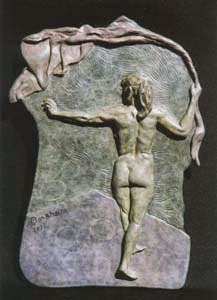Dear Art-loving friend,
My friend and fellow sculptor here in Florence, Italy, enjoys giving lectures on art and art history. Jason Arkles has recently created a new series of podcasts, called “The Sculptor’s Funeral.” That title alone ought to get some attention!
The podcast that I listened to this Sunday morning was all about the sculptor Donatello. He has not been one of my favorite artists, but Jason makes a great argument on why I should never discount Donatello’s importance or creativity. Give it a listen, will ya?
Over fifteen years ago, I took a sculpture class from Eugene Daub. We did a portrait in plastilina in three days and studied bas-relief sculpture the last two days of the week-long workshop in Colorado. Eugene made bas relief interesting to me because for some reason, I had not understood the possibilities of having a sculpted figure INSIDE of an environment. Looking back, I probably just had very little experience looking at bas-relief sculpture in general. The idea of adding architectural “frames” around a figure intrigued me. I remember thanking Eugene for opening my eyes to this art form, admitting that I had only thought before of bas-relief sculpture as “Puffy Painting” and had not been interested in it. He seemed amused.
Eugene Daub taught bas relief with the same idea that my friend Vasily Fedorouk did: as compressed form. From then on, I looked at bas-relief in that way. I had often assumed that some artists just did that badly. Perhaps you can imagine my surprise this morning to hear Jason’s voice coming through my laptop to say that Donatello was the first sculptor to understand and successfully demonstrate this idea. Sculptors before used mainly outlines to describe their forms!
Since Eugene’s class I have tackled many bas relief compositions. Here are just a few:
"Oh Boy!" [Mirror of Men, what a fun way to brush one’s teeth in the morning!], "Rehearsal" (the woman waving the large fabric over her head), and "Infinity" (created for the eighth wedding anniversary gift of bronze material, note the figure eight as the outside shape).
I have been thinking of new compositions to create in bas-relief because I think the story-telling ability is very similar to painting in that respect. But I hope you enjoy the compositions that I have created thus far.
[Ask, please, about availability, or commission some art for yourself or another.]
Thank you for your interest and enthusiasm,
Kelly
~ Kelly Borsheim, sculptor, painter, writer, teacher
http://BorsheimArts.com
My friend and fellow sculptor here in Florence, Italy, enjoys giving lectures on art and art history. Jason Arkles has recently created a new series of podcasts, called “The Sculptor’s Funeral.” That title alone ought to get some attention!
The podcast that I listened to this Sunday morning was all about the sculptor Donatello. He has not been one of my favorite artists, but Jason makes a great argument on why I should never discount Donatello’s importance or creativity. Give it a listen, will ya?
 |
| "Oh Boy!" bronze mirror of men |
Over fifteen years ago, I took a sculpture class from Eugene Daub. We did a portrait in plastilina in three days and studied bas-relief sculpture the last two days of the week-long workshop in Colorado. Eugene made bas relief interesting to me because for some reason, I had not understood the possibilities of having a sculpted figure INSIDE of an environment. Looking back, I probably just had very little experience looking at bas-relief sculpture in general. The idea of adding architectural “frames” around a figure intrigued me. I remember thanking Eugene for opening my eyes to this art form, admitting that I had only thought before of bas-relief sculpture as “Puffy Painting” and had not been interested in it. He seemed amused.
Eugene Daub taught bas relief with the same idea that my friend Vasily Fedorouk did: as compressed form. From then on, I looked at bas-relief in that way. I had often assumed that some artists just did that badly. Perhaps you can imagine my surprise this morning to hear Jason’s voice coming through my laptop to say that Donatello was the first sculptor to understand and successfully demonstrate this idea. Sculptors before used mainly outlines to describe their forms!
 |
| "Rehearsal" bronze bas relief / wall hanging |
"Oh Boy!" [Mirror of Men, what a fun way to brush one’s teeth in the morning!], "Rehearsal" (the woman waving the large fabric over her head), and "Infinity" (created for the eighth wedding anniversary gift of bronze material, note the figure eight as the outside shape).
I have been thinking of new compositions to create in bas-relief because I think the story-telling ability is very similar to painting in that respect. But I hope you enjoy the compositions that I have created thus far.
[Ask, please, about availability, or commission some art for yourself or another.]
Thank you for your interest and enthusiasm,
Kelly
~ Kelly Borsheim, sculptor, painter, writer, teacher
http://BorsheimArts.com
 |
| "Infinity" bronze bas-relief sculpture by Kelly Borsheim |

2 comments:
You are a super fine artist! I really like these. Thanks for the podcasts, too.
Thank you, Jo! I missed this comment of yours.
Have a wonderful Thanksgiving to you and Gene!
Post a Comment